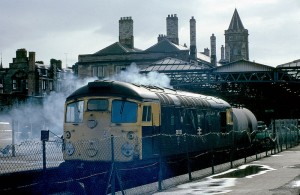Perth Railway Station, Scotland

Perth Railway Station, Scotland
Perth Railway Station History, South Inch Perth, Tay Rail Bridge Perth,Dundee to Perth Railways. Barnhill, Scottish Central Railways.
 Perth railway station is a railway station located in the city of Perth, Scotland. The station, designed by Sir William Tite, won an architecture prize. It has seven platforms, five of which are “through” platforms.
Perth railway station is a railway station located in the city of Perth, Scotland. The station, designed by Sir William Tite, won an architecture prize. It has seven platforms, five of which are “through” platforms.
There are two entrances, both of which allow car parking. The ticket office, newsagent and café are between Platforms 2 and 3. The original main concourse was between the current Platforms 4 and 7 and the station was covered by a large overall roof, which still exists in a reduced form. At one time there were nine platforms.
The station here was opened (as Perth General) by the Scottish Central Railway in 1848. Originally the terminus of the SCR main line from Greenhill Junction near Glasgow, it soon became a junction of some importance with the arrival of the Dundee and Perth Railway from Dundee (following the completion of a bridge across the River Tay), the Edinburgh and Northern Railway from Ladybank on the Fife coast and the Scottish Midland Junction Railway from Forfar within months. Subsequent construction by the Perth and Dunkeld Railway and thePerth, Almond Valley and Methven Railway added further lines into/out of the city, with the former becoming part of what is now the Highland Main Line to Inverness. The SMJR meanwhile would become part of a through route to Aberdeen by 1856, thus giving Perth travellers easy access to all of the major Scottish cities.
All of these lines, apart from the E&NR would eventually be taken over by the Caledonian Railway, though the Highland Railway (which took over the P&DR} and North British Railway (which absorbed the E&NR) also had access by means of running powers from Stanley Junction and Hilton Junction respectively.
The NBR would subsequently open a more direct route to the Scottish capital than the Caledonian’s route via Stirling and the central lowlands in 1890 – this left the existing Ladybank line at Bridge of Earn and headed south via Glenfarg to Mawcarse, where it joined the Fife and Kinross Railway’s line to Kinross. Trains could then travel via Cowdenbeath, Dunfermline and the newly opened Forth Rail Bridge to reach Edinburgh.
The Almond Valley line to Crieff & Methven was an early post-nationalisation casualty, closing to passengers in October 1951 whilst the Ladybank service followed suit in September 1955. The major losses though came as the result of the Beeching Axe and its aftermath in the mid-to-late 1960s, with the ex-SMJR main line to Kinnaber Junction via Coupar Angus and Forfar being closed to passenger traffic on 4 September 1967; Aberdeen services were thereafter routed via Dundee and the former NBR route via Montrose. The Aviemore to Forres section of the Highland Main Line had already been closed two years earlier, whilst several local stations in the area were also shut down around this time.
A further significant (and controversial) closure came on 5 January 1970, when the Glenfarg line to Kinross & Cowdenbeath was abandoned in favour of the older but less direct line via Stirling. This route had been recommended for retention & development in the Beeching Report, but its removal allowed the planned M90 motorway to occupy its former alignment in the Glenfarg area when it was built a few years later. The additional time penalty associated with the re-routing proved unpopular with Edinburgh travellers though and so in 1975, the old E&NR line to Ladybank was reopened by British Rail to provide a slightly quicker alternative – this is the route followed by most Edinburgh services today, though the daytime & overnight trains to London (see below) still run via Stirling & Falkirk.
As mentioned above, the station has seven active platforms – these are however split into two distinct sections. Platforms 1 & 2 sit on the eastern side (the old Dundee & Perth Railway part of the station) and are the busiest in the station due to them handling the Glasgow to Dundee & Aberdeen trains. The two platform lines then become single further east to cross the bridge spanning the Tay. The remainder of the platforms (3-7) sit under the main train shed – these are the former HR/SMJR platforms once used by the Coupar Angus main line as well as services to the Highlands, but are now only used by terminating trains from the Edinburgh direction and around a dozen trains per day each way on the Highland Main Line.
There was once an extensive goods yard here, along with an engine shed & carriage sidings but only a small engineers depot now remains in the greatly downsized yard.
Services
 Passenger services are operated by First ScotRail and East Coast, and the station is staffed throughout its opening hours.
Passenger services are operated by First ScotRail and East Coast, and the station is staffed throughout its opening hours.
There are two main routes passing through the station – the Glasgow to Dundee & Aberdeen Line and the Highland Main Line, whilst there is now also a regular service to/from Edinburgh via the Fife Coast. Services to both Glasgow Queen Street and Edinburgh Waverley depart hourly (with some extras to Glasgow), as do those to Aberdeen via Dundee, Carnoustie and Arbroath. Trains to Inverness are somewhat irregular, but run at least once every two hours with eleven departures in all on weekdays & Saturdays and seven on Sundays.
The daily (overnight) Caledonian Sleeper service between Inverness and London and the daily East Coast Highland Chieftainservice between Inverness and London Kings Cross call at this station.
http://en.wikipedia.org/wiki/Perth_railway_station,_Scotland




